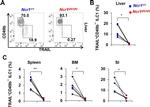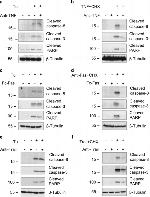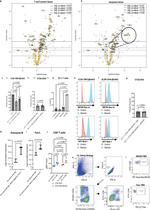Search Thermo Fisher Scientific
Invitrogen
CD253 (TRAIL) Monoclonal Antibody (N2B2), Functional Grade, eBioscience™
Product Details
16-5951-85
Species Reactivity
Published species
Host/Isotype
Recommended Isotype Control
Class
Type
Clone
Conjugate
Form
Concentration
Purification
Storage buffer
Contains
Storage conditions
Shipping conditions
RRID
Product Specific Information
Description: The N2B2 monoclonal antibody reacts with mouse TNF-related apoptosis-inducing ligand (TRAIL), a member of the TNF superfamily. TRAIL is not detected on the surface of freshly isolated T, B, or NK cells, but can be induced preferentially on CD3^- NK1.1^+ NK cells after stimulation with IL-2 or IL-15. N2B2 inhibits IL-2- or IL-15-activated NK cell cytotoxicity against mouse fibrosarcoma L929 target cells.
Applications Reported: N2B2 has been reported for use in flow cytometric analysis, and blocking of TRAIL in functional assays.
Applications Tested: The N2B2 antibody has been tested by flow cytometric analysis of mouse TRAIL transfected cells and can be used at less than or equal to 1 µg per test. A test is defined as the amount (µg) of antibody that will stain a cell sample in a final volume of 100 µL. Cell number should be determined empirically but can range from 10^5 to 10^8 cells/test. It is recommended that the antibody be carefully titrated for optimal performance in the assay of interest.
Storage and handling: Use in a sterile environment.
Filtration: 0.2 µm post-manufacturing filtered.
Purity: Greater than 90%, as determined by SDS-PAGE.
Endotoxin Level: Less than 0.001 ng/µg antibody, as determined by LAL assay.
Aggregation: Less than 10%, as determined by HPLC.
Target Information
TRAIL is a cytokine that belongs to the tumor necrosis factor (TNF) ligand family. TRAIL preferentially induces apoptosis in transformed and tumor cells, but does not appear to kill normal cells although it is expressed at a significant level in most normal tissues. TRAIL binds to several members of TNF receptor superfamily including TNFRSF10A/TRAILR1, TNFRSF10B/TRAILR2, TNFRSF10C/TRAILR3, TNFRSF10D/TRAILR4, and possibly also to TNFRSF11B/OPG. The activity of this protein may be modulated by binding to the decoy receptors TNFRSF10C/TRAILR3, TNFRSF10D/TRAILR4, and TNFRSF11B/OPG that cannot induce apoptosis. The binding of TRAIL protein to its receptors has been shown to trigger the activation of MAPK8/JNK, caspase 8, and caspase 3. Receptors for TRAIL include two death domain containing receptors, death receptor 4 (DR4) and DR5, as well as two decoy receptors, DcR1 and DcR2, lacking the intracellular signaling death domain. TRAIL is a type II membrane protein and expressed in a variety of human tissues. Like TNF and Fas ligand, TRAIL induces apoptosis and NF-kB activation in many tissues and cells.
For Research Use Only. Not for use in diagnostic procedures. Not for resale without express authorization.
Bioinformatics
Protein Aliases: CD253; CD253 antigen; Protein TRAIL; TNF superfamily member 10; TNF-related apoptosis inducing ligand; TNF-related apoptosis-inducing ligand; TRAIL protein; TRAIL/APO2L; Tumor necrosis factor ligand superfamily member 10
Gene Aliases: A330042I21Rik; AI448571; APO-2L; Ly81; TL2; Tnfsf10; Trail
UniProt ID: (Mouse) P50592
Entrez Gene ID: (Mouse) 22035

Performance Guarantee
If an Invitrogen™ antibody doesn't perform as described on our website or datasheet,we'll replace the product at no cost to you, or provide you with a credit for a future purchase.*
Learn more
We're here to help
Get expert recommendations for common problems or connect directly with an on staff expert for technical assistance related to applications, equipment and general product use.
Contact tech support
-Functional-Grade-Flow-20170216130641.jpg?time=20220826)
-Functional-Grade-Flow-20170216130641.jpg?time=20220826)



